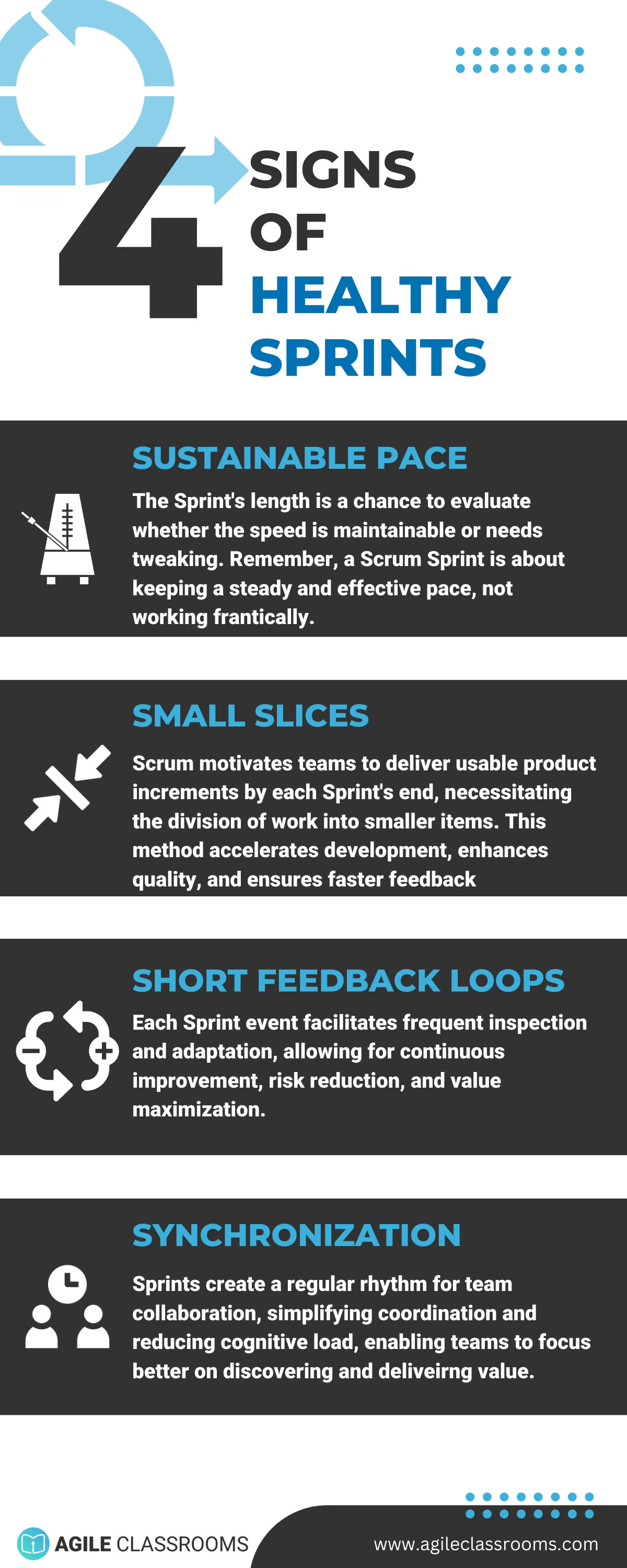Four Principles for Healthy Sprints In Scrum
The 4S's: Short Feedback, Small Slices, Sustainable Pace, and Synchronization
Agile, known for its adaptability and rapid value delivery, often leverages the Scrum framework to embody these traits. Sprints, a core component of Scrum, are designed to facilitate this fast-paced, iterative process. However, when misapplied, Sprints can give rise to 'Dark Scrum,' where the process overshadows the product and the people behind it. To avoid this pitfall and promote what is known as 'Bright Scrum,' it is essential to adhere to four key principles within your Sprints: Short Feedback Loops, Small Slices, Sustainable Pace, and Synchronization.
Short Feedback Loops: Each Sprint event facilitates frequent inspection and adaptation, allowing for continuous improvement, risk reduction, and value maximization. Sprints enables teams to stay aligned with user needs, respond to change, and learn faster.
Small Slices: Scrum encourages teams to deliver usable and hopefully valuable product increments at the end of each Sprint, emphasizing the need to break down work into smaller, more manageable items. Small backlog items get done faster. The faster we are done, the faster we can learn if it really works. The faster we learn, the sooner we can iterate and ensure we deliver value while reducing waste. Small is smooth, and smooth is fast.
Sustainable Pace: A sustainable pace is critical for maintaining team well-being and consistent output. The Sprint's short length is a chance to evaluate whether the speed is maintainable or needs tweaking. Remember, a Scrum Sprint is about keeping a steady and effective pace, not working frantically. No, you do not need a break from a Sprint to reset; you need to ensure you work at a sustainable pace in the Sprint.
Synchronization: The consistent cadence established by Sprints streamlines collaboration and reduces the cognitive load required for coordination. The predictable and repeating tempo of each Scrum event alleviates the burden of scheduling and planning meetings, allowing teams to concentrate more effectively on innovating and delivering value. With this regular rhythm in place, the need to juggle coordination diminishes. Teams can readily align their schedules for planning and seamlessly integrate stakeholder feedback sessions into their workflow, ensuring that progress reviews are timely and productive.
When these principles are ignored or inverted, the consequences can be dire:
Without Short Feedback Loops, teams can spend cycles developing features that no longer meet user needs or miss out on critical improvements, leading to a product that fails to resonate with its intended audience.
Neglecting to break down product backlog items into Small Slices and instead taking on large, complex features can obscure transparency, delay critical feedback, and hinder the overall development path. This approach often leads to deployment setbacks and makes it challenging to recognize and celebrate incremental successes essential for sustaining team morale and momentum. By focusing on slicing work into smaller, more manageable increments, teams can ensure a clearer, more progressive development journey. This strategy accelerates feedback loops and avoids the common trap of cramming too much into each sprint, facilitating steady and measurable advancement.
Forgoing a Sustainable Pace in favor of a relentless and frantic pace, working overtime can burn out even the most resilient and energetic teams, resulting in a decline in both the quality of the work produced and the overall health of the team dynamic.
The absence of a synchronization tempo can fragment team mental efforts, forcing them to focus on team and stakeholder coordination rather than the actual discovery and development work. This results in cognitive and administrative overhead associated with arranging collaborative planning sessions, synchronizing efforts, adapting to changes, obtaining feedback, and engaging in continuous improvement activities. Such distractions can divert the team's attention from their primary goal: delivering meaningful value while minimizing waste.
The 4 S's of Healthy Sprints fosters a productive and healthy Agile environment. Conversely, neglecting these tenets can introduce a cascade of issues that undermine the Agile ethos. By championing the 4 S's, Scrum teams can confidently navigate the complexities of product development, ensuring they deliver exceptional products and sustain a thriving, collaborative, and happy team culture.
Understanding how to enable healthy Sprints is just the start. To dive deeper into the journey from checklist-driven Dark Scrum to the culture-centric Bright Scrum, consider exploring further insights in the article "Dark Scrum, Bright Scrum: From Checklists to Culture," which comprehensively looks at aligning Scrum with the Agile values and principles. You can download 4S of Healthy Sprints Infographic here for free.




